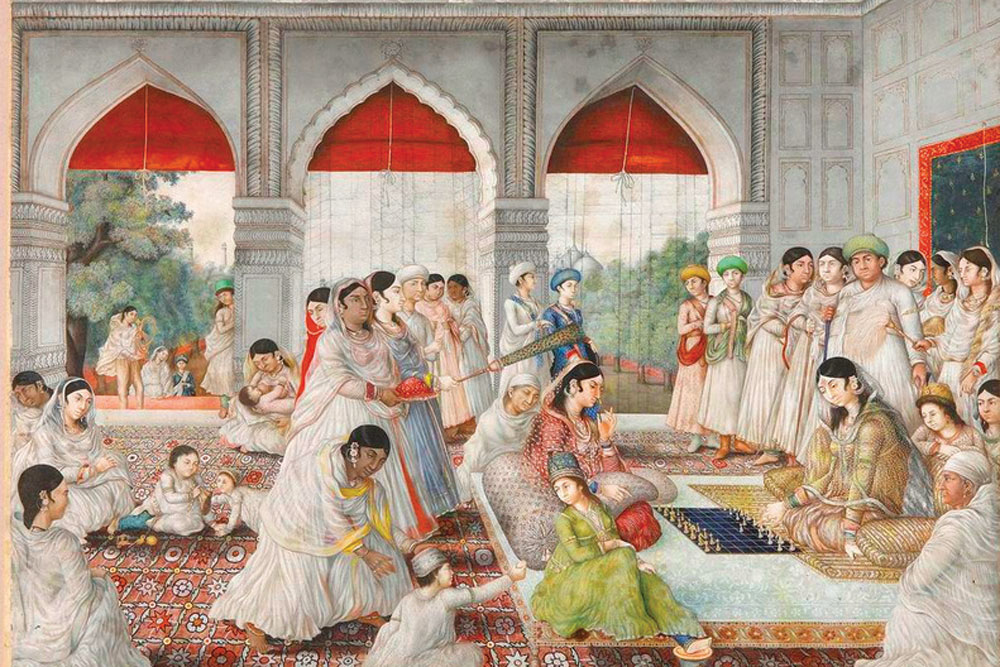How the begums of Awadh had stood up to the East India Company
Queens of resistance
 Ira Mukhoty
Ira Mukhoty
 Ira Mukhoty
Ira Mukhoty
 |
03 Mar, 2023
|
03 Mar, 2023
/wp-content/uploads/2023/03/Awadh.jpg)
A portrait of the likeness of Bahu Begum of Awadh
IN 1816, A VERY OLD WOMAN LAY DYING IN FAIZABAD, ONCE CAPITAL OF THE GREAT PROVINCE of Awadh. The day before she died, the woman opened her eyes one last time to whisper that the ‘Barre Nawab’ had come to take her. She repeated these words the next day to her favourite eunuch, who wept by her side, and then quietly passed away, while the keening grief and desolation of her elderly maids filled the sudden silence. When she was buried, the reigning Nawab of Awadh Ghaziuddin Haidar had her clothes buried too, so that even the garments that had touched her body should never be seen by strangers. The purdah that this woman had lived behind her entire life had been entirely opaque, her conduct completely irreproachable. And yet, she was the veritable scourge of the East India Company (EIC) officials in the late 18th century and quite simply one of the most powerful women of her time in India.
When Ummat uz Zohra Begum had married the dashing Nawab of Awadh Shuja-ud-Daula in 1747, she could very well have disappeared forever into the anonymity of the Nawab’s zenana, obscured by the countless women in the famously libertine Nawab’s life. But Zohra Begum had been adored and raised by the Mughal Padhshah Muhammad Shah ‘Rangeeley’ himself, who had affectionately called her Bahu Begum after her wedding. Bahu Begum’s wedding trousseau or ‘mehr’ had been the stuff of legends, and had included one thousand and one dishes of silver, in addition to revenue-generating lands, and countless jewels. Later on, Bahu Begum would invest her money in commercial enterprises in Awadh and all this wealth, which she firmly considered her own personal property, would form the basis of her enormous future prestige and power. And yet, without the cataclysmic events of 1764, Bahu Begum would have remained simply an opulent noblewoman among the countless women that surrounded the philandering Nawab. But destiny, and the anarchy of the 18th century, brought the Begum and her swashbuckling husband to a frightening and unexpected precipice, one from which the Begum was able to save both herself and her husband, with great panache.
In 1764 a battle was fought between the combined forces of the Mughals, Bengal and Awadh, against the forces of the EIC, on a dusty field at Baksar. Leading the Mughal forces was the charismatic young Nawab Shuja-ud-Daula himself, “extremely handsome in his person, about five feet eleven inches in height and so nervous and strong that with one stroke of the sabre he could cut off the head of a buffalo,” according to one admiring European. Just 30 years old, dashing and fiercely moustachioed, he was widely regarded as one of the most redoubtable leaders in all of India. The Nawab himself was disdainful about the English forces and was supremely confident about being able to extirpate these grasping, greedy foreigners out of the country altogether. But the Mughal forces were defeated and a triumphant EIC imposed an indemnity of 5 million rupees on the devastated Nawab, to recover Awadh.
His coffers empty after the Battle of Baksar, the Nawab searched desperately for allies who would loan him the money, but all his friends and family turned away, except for Bahu Begum. Entirely unexpectedly, Bahu Begum generously offered up her enormous dowry to Shuja-ud-Daula, gathering all that she could—cash, jewels, gold and silver plates, expensive furniture and the jewels she was wearing. She even removed her nose-ring with its bunch of pearls, sacred symbol of her married status, and when her horrified entourage rushed to stop her, she replied with supreme gallantry, “whatever I have is of use to me so long as Shuja-ud-Daula is safe. If he ceases to live, all these things (wealth and ornaments) would also cease to be of value to me” (from Memoirs of Delhi and Faizabad by Muhammad Faiz Baksh).
Perhaps if she had been a simpering sot, a more ‘gentlemanly’ attitude may have been assured. But Bahu Begum was aggressive, outspoken, impetuous and fiery. Whereas to her own people and soldiers, the Begum was simply the ruler, to Governor General Warren Hastings she was a mere woman
With his lands restored to him, Shuja-ud-Daula returned to Faizabad where he would be extravagantly grateful to Bahu Begum, singling her out for the greatest honours and privilege. He never would forget the great debt he owed Bahu Begum, entrusting the seals of his government into her custody and on a more personal note, dining both times of the day at her palace with her, despite his tenacious wandering ways. Bahu Begum would always remain till the end of his days “his best friend and his confidant, the guardian of all his secrets and his treasures.” Indeed, for the infamously wayward Nawab, this would be a moment of startling reckoning. He would always remain a great patron of beautiful and talented courtesans, and he would father more than 50 children by the end of his life, but his steadfast loyalty and his visible celebration of Bahu Begum’s untouchable status in his life and in his household was completely unwavering. Bahu Begum would be his only ‘Khaas Mahal’, his chief consort, and he married no other woman by nikah, even though up to four nikah wives was allowed for Shia Muslims.
A piquant detail of the Nawab’s gratitude was that he was supposed to have promised to spend his nights in the Begum’s palace. Whenever his tempestuous nature got the better of him, tradition has it he had to pay Bahu Begum 5,000 rupees per transgression, as agreed. Whether or not these debts were paid, at the time of Shuja-ud-Daula’s death in 1775 Bahu Begum’s wealth was estimated at 2 million pounds, making her an extremely wealthy and powerful woman.
The ease with which Shuja-ud-Daula had been able to pay off the fines imposed by the EIC had had another, less felicitous effect—the English had been alerted to the enormous wealth and resources available to Indian rulers. And so, when Shuja-ud-Daula died suddenly in 1775 the increasingly rapacious EIC began sizing up the new Nawab, Bahu Begum’s son Asaf-ud-Daula, intending to extract as much money as possible from their young ‘ally’. But even as she exchanged her sparkling jewellery and embroidered clothes for the spartan robes of a widow, Bahu Begum remained acutely aware of the source of her power and prestige at Faizabad—the enormous inheritance she controlled. While later chroniclers, and especially the English, would noisily berate the Begum for withholding from her son Asaf-ud-Daula (and thereby the Company), wealth that was supposedly his inheritance, it is clear that for the Begum the wealth in her possession was almost entirely due to unalienable gifts the Nawab had made to her in his own lifetime, and therefore quite exempt from inheritance her son was entitled to. She was also very articulate about the fact that Shuja-ud-Daula only possessed Awadh in the first place because of her own financial contributions at the critical time of Baksar. Indeed, in a letter she sent to Governor General Warren Hastings in 1775, Bahu Begum reminded him that “everything paid to the English gentlemen by the late nawab (in 1765 ie after Baksar) had been taken from me.”
By 1780, the claims by the English on the Begum’s wealth at Faizabad had become incessant and intolerable. Hastings had developed an appetite for money that had become quite insatiable by this point, largely fuelled by the wars the English were embroiled in against the French. And Hastings was about to make a decision that would cost him his reputation and decades of his life facing an impeachment trial because he was about to attack the formidable Bahu Begum herself.

In 1781, Hastings decided to raise funds for the English overseas war efforts by levying emergency taxes on the Begum’s neighbour, Raja Chait Singh of Benares. When the Raja demurred, Hastings reacted with astonishing arrogance. He came to Benares and placed the Raja under arrest in his own palace. This egregious imprisonment of the Raja in his own homeland had an electrifying effect on his troops, who swarmed up to the palace where he was being held in a great brawl of furious, bellowing men and slaughtered the sepoys guarding him, including the English officers. The Raja jumped down to the river by means of a rope made of turbans tied together and escaped by boat, followed by his triumphant, riotous soldiers. In what must had seemed like an instant, the town was swirling with the Raja’s men, barricading the lanes and firing weapons. Rumours fizzed with as much velocity as the bullets ricocheting off the narrow lanes and when Hastings heard news of an attack being prepared at neighbouring Ramnagar, he fled from Benares to the fort of Chunar, abandoning the wounded sepoys, and losing all baggage, provisions, and palanquins in the great confusion of his escape.
This incendiary reaction was not limited to Benares, for it spread like wildfire in every direction. As Hastings made his desperate flight from Benares to Chunar triumphant rumours proclaimed the governor general’s massacre, and witnesses made wild-eyed claims of having seen ‘his head and right hand suspended over the gateway of Chait Singh’s fortress.’ Across the country of Awadh sepoys deserted their posts, zamindars hustled together in secret communications and European settlements were seized with panic.
Even as she exchanged her jewellery and clothes for the spartan robes of a widow, Bahu Begum remained aware of the source of her power and prestige at Faizabad—the enormous inheritance she controlled. She was articulate about the fact that Shuja-ud-Daula only possessed Awadh in the first place because of her own financial contributions at the critical time of Baksar
A conflagration of the sort that was witnessed in Awadh in the torpid monsoon season of 1781 could not have occurred without the knowledge and concerted efforts and encouragement of the most powerful force in the country, the Begums of Awadh—Bahu Begum and her mother-in-law Nawab Begum. The Begums had begun to greatly resent the constant demands for money the Company made and more objectionable still, the violent and venal methods used by Company-appointed revenue farmers on lands that the Begums claimed as theirs.
“In the city of Faizabad,” agreed Hastings angrily, “Nawab Aliya and (Bahu Begum), the mother and grandmother of the Nabob, openly espoused the party of Chait Singh, encouraging and inviting people to list for his service, and their servants took up arms against the English” (according to an official communication to the Calcutta Council). It was widely acknowledged by the English that the Begums’ favourite eunuchs acted for the Begums and recruited troops in the bazaars of Faizabad, stopped provisions from being sold to the English, disabled the postal relay system of the English, and commanded the attack on isolated Company contingents. By mid-September, bands of 10,000 rebel soldiers were attacking the reinforcements arriving from Bengal. Nor was the violence confined simply to the cities, as the rural population also attacked incoming sepoy soldiers.
The English reacted by seizing Bahu Begum’s lands, and imprisoning her eunuchs, aggressions that the Begum loudly and stoutly opposed. “She denounces death and destruction to the most trifling opposition,” wrote the English Resident with horror, about this purdah-bound ‘native’ woman who dared to loudly proclaim her right to her autonomy, independence and wealth. For the righteousness of the Begum’s cause resonated perfectly with the role of the feminine voice in Shia remembering. From the time of the great massacre at Karbala, it was the voice of Zainab, sister of Imam Hussain, that would be raised in the very first majlis to lament the martyrdom of Imam Hussain. It was the women of Prophet Muhammad’s household, who were entrusted with the precious duty of lamenting and recalling the sacrifice of the men. And it was Bahu Begum who had negotiated a visible presence as a devoted Shia woman and who now demanded justice from her English oppressors.
Despite more than a year of intense pressure and constant negotiations, the Begums’ fortunes were left largely untouched. A total of 5.5 million rupees in all was recovered from them, mostly in moveable assets. In time, almost all of Bahu Begum’s lands were restored to her, and she held them till her death in 1815. Despite nearly impossible pressure from the EIC, Bahu Begum would retain control over her wealth, rumoured to have amounted to some 20 million rupees.
Hastings, who had led these attacks, however, would face ignominy and disgrace, and a ruinously long trial for impeachment for the ‘despoliation’ of the Begums. His attitude towards the Begums, and especially the younger Bahu Begum, was one of impenitent fury. Perhaps if she had been a simpering sot, a more ‘gentlemanly’ attitude may have been assured. But Bahu Begum was aggressive, outspoken, impetuous and fiery. Whereas to her own people and soldiers, the Begum was simply the ruler, to Hastings she was a mere woman.
Bahu Begum was entirely true to her word, when she had threatened the Company that the country would fall if she fell. She remained undaunted, counting on a fragile claim to immunity on the basis of the respect due to her as a pious Shia noblewoman. In the end, it was Hastings whose reputation would suffer for his perceived violence towards the Begums, and it was Asaf-ud-Daula whom posterity would remember as the wastrel son of an indomitable mother. It was Bahu Begum, invisible but omnipresent, who maintained her impeccable reputation as an exemplary Shia woman till her death.

/wp-content/uploads/2025/05/Cover-AfterPahalgam.jpg)












More Columns
Rubio asks India, Pak to de-escalate but asks Sharif to stop support to terrorism Rajeev Deshpande
Pakistan Launches Another Wave of Attacks on India Open
Major Escalation by Pakistan Open